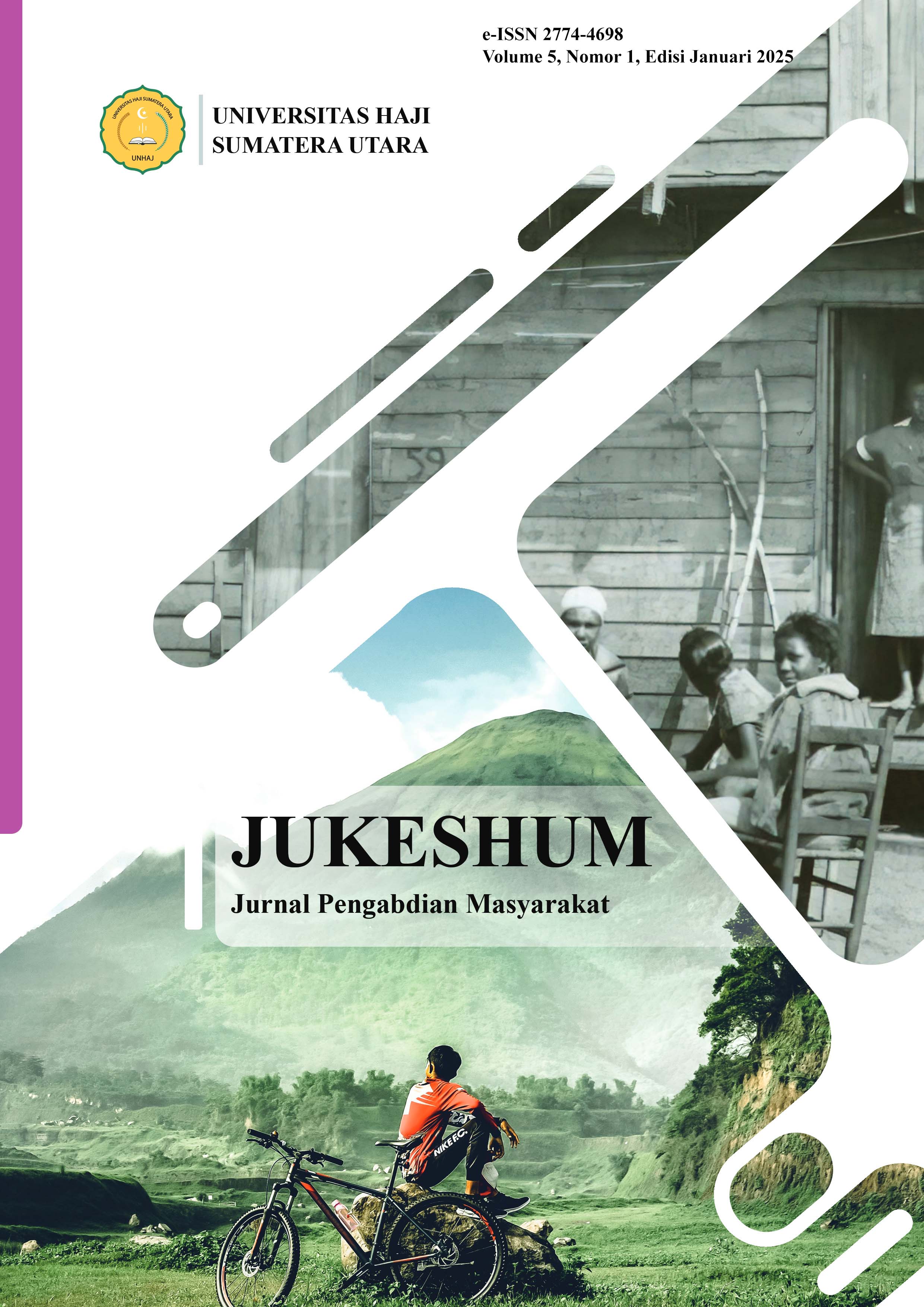Socialization of Healthy Curly Meatball Processing for Diabetes Mellitus in the Benteng Hilir Complex Housing
Sosialisasi Pengolahan Bakso Keriting Sehat Untuk Diabetes Melitus di Perumahan Komplek Benteng Hilir
DOI:
https://doi.org/10.51771/jukeshum.v5i1.1292Keywords:
Curly Meatballs, Diabetes Mellitus, ProcessingAbstract
Diabetes Mellitus is the second type of metabolic disease characterized by increased blood sugar levels due to abnormalities in insulin production. The quite high mortality caused by diabetes mellitus is most often experienced by adults and does not cover children and teenagers. This is due to increased body weight or obesity due to an unbalanced diet. Apart from that, less activity and less exercise causes an increase in blood sugar levels. In general, this disease is often ignored and is not a disease that sufferers experience. In fact, without realizing it, his health condition began to be disturbed for quite a long time, coupled with the condition of blood glucose levels above the normal average which is a characteristic of diabetes mellitus. Hyperglycemia can be caused by a lack of knowledge regarding how to manage diabetes mellitus. Apart from that, information about diabetes mellitus education can also be a cause of hyperglycemia. The aim of this service is to increase the knowledge of diabetes mellitus sufferers about the disease process, prevention, complications and management of diabetes mellitus. Socialization activities regarding the processing of curly meatballs for diabetes mellitus patients were carried out at the Benteng Hilir Housing Complex with a total of 22 respondents. The counseling method is carried out by conducting health checks on family members who have sufferers in the family and conducting socialization on the processing of making curly meatball food for diabetes sufferers.
References
Afridah, W., & Firdausi, N. J. (2018). Waspada Diabetes Melitus: Analisis Perilaku Berisiko pada Peningkatan Kasus Diabetes Melitus di Indonesia. Prosiding Seminar Profesi Kesehatan Masyarakat, 132–137.
Kementrian Kesehatan RI, 2019. Buku Pintar Kader Posbindu, Direktorat Jenderal Pencegahan dan Pengendalian Penyakit Direktorat Pencegahan dan Pengendalian Penyakit Tidak Menular.
Kurniawati, T., Huriah, T., & Primanda, Y. (2019). Pengaruh Diabetes Self Management Education (DSME) terhadap self management pada pasien diabetes mellitus. Jurnal Ilmiah Kesehatan, XII(Ii), 588–594.
Mirza M, Cahyady E, D. M. (2021). Gambaran Faktor Risiko Diabetes Mellitus Tipe-II pada Pasien Poliklinik Penyakit Dalam di Rumah Sakit Meraxa Kota Banda Aceh Tahun 2018. Kandidat: Jurnal Riset Dan Inovasi Pendidikan, 2(2), 35–41. Retrieved from http://jurnal.abulyatama.ac.id/index.php/kandidat/article/view/794
Nguru, N. (2023). Faktor Risiko Timbulnya Diabetes Melitus Tipe II Pada Remaja Di SMA Negeri 3 Kota Kupang (Doctoral dissertation, Poltekkes Kemenkes Kupang).
Qifti, F., Malini, H., & Yetti, H. (2020). Karakteristik Remaja SMA dengan Faktor Risiko Diabetes Melitus di Kota Padang. Jurnal Ilmiah Universitas Batanghari Jambi, 20(2), 560-563.
Rahmawati, F., Natosba, J., & Jaji, J. (2016). Skrining Diabetes Mellitus Gestasional dan Faktor Risiko yang Mempengaruhinya. Jurnal Keperawatan Sriwijaya, 3(2), 33–43.
Sari, N., & Purnama, A. (2019). Aktivitas Fisik dan Hubungannya dengan Kejadian Diabetes Melitus. Window Of Health Jurnal Kesehatan, 2(4), 368–381.
Watta, R., Masi, G., & Katuuk, M. E. (2020). Screening Faktor Resiko Diabetes Melitus Pada Individu Dengan Riwayat Keluarga Diabetes Melitus Di Rsud Jailolo. Jurnal Keperawatan, 8(1), 44. https://doi.org/10.35790/jkp.v8i1.28410
Wigunantiningsih, A. (2022). Screening Faktor Risiko Diabetes Millitus ( DM ) Di Masa. Jurnal Abdimas PHB, 5(2), 235–241.
Downloads
Published
Issue
Section
License
Copyright (c) 2025 Zuidah Zuidah, Sumiatik Sumiatik, Indah Wati, Sukma Yunita, Fitriani Fadillah

This work is licensed under a Creative Commons Attribution-ShareAlike 4.0 International License.
Hak Cipta dan Lisensi
Penulis yang mempublikasikan naskahnya melalui Jukeshum: Jurnal Pengabdian Masyarakat menyetujui beberapa hal berikut:
- Hak Cipta atas naskah-naskah karya ilmiah di dalam Jurnal ini dipegang oleh Penulis.
- Penulis menyerahkan hak saat pertama kali mempublikasi Naskah karya ilmiahnya dan secara bersamaan Penulis memberikan izin/lisensi dengan mengacu pada Creative Commons Attribution-ShareAlike 4.0 International License kepada pihak lain untuk menyebarkan karya ilmiahnya tersebut dengan tetap mencantumkan penghargaan bagi penulis dan Jukeshum: Jurnal Pengabdian Masyarakat sebagai media Publikasi pertama atas karya tersebut.
- Hal-hal yang berkaitan dengan non-eksklusivitas pendistribusian Jurnal yang menerbitkan karya ilmiah penulis dapat diperjanjikan secara terpisah (contoh: permintaan untuk menempatkan karya yang dimaksud pada perpustakaan suatu institusi atau menerbitkannya sebagai buku) dengan Penulis sebagai salah satu pihak perjanjian dan dengan penghargaan pada Jukeshum: Jurnal Pengabdian Masyarakat sebagai media publikasi pertama atas karya dimaksud.
- Penulis dapat dan diharapkan untuk mengumumkan karyanya secara online (misalnya pada Repositori atau pada laman Organisai/Institusinya) sejak sebelum dan selama proses pengumpulan naskah, sebab upaya tersebut dapat meningkatkan pertukaran citasi lebih awal dan dengan cakupan yang lebih luas.








